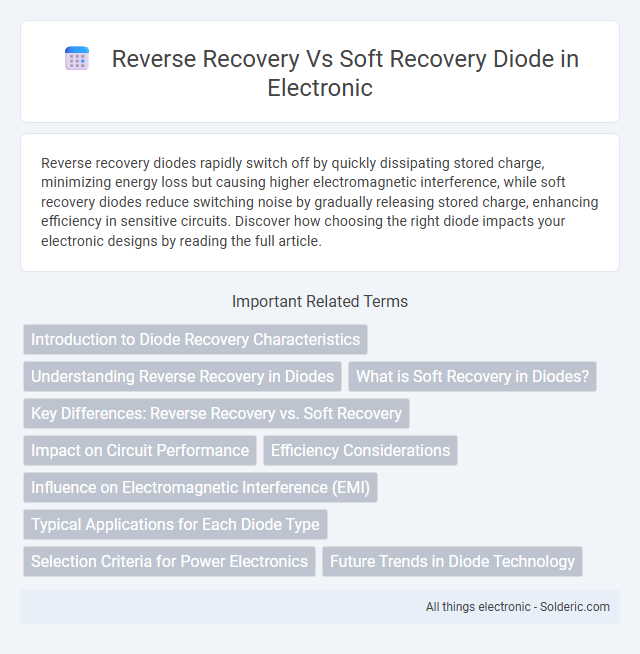Reverse recovery diodes rapidly switch off by quickly dissipating stored charge, minimizing energy loss but causing higher electromagnetic interference, while soft recovery diodes reduce switching noise by gradually releasing stored charge, enhancing efficiency in sensitive circuits. Discover how choosing the right diode impacts your electronic designs by reading the full article.
Comparison Table
| Feature | Reverse Recovery Diode | Soft Recovery Diode |
|---|---|---|
| Recovery Type | Sharp, abrupt switch from conduction to blocking mode | Smooth, gradual transition to reduce switching noise |
| Switching Speed | Faster switching with high Reverse Recovery Time (trr) | Moderate switching speed with controlled trr |
| Switching Loss | Higher switching losses due to abrupt current change | Lower switching losses from reduced current spikes |
| Electromagnetic Interference (EMI) | High EMI caused by rapid current changes | Minimized EMI with smooth recovery waveform |
| Applications | High-speed switching power electronics, general diode use | High-efficiency power converters, low noise circuits |
| Cost | Lower cost | Typically higher cost due to specialized design |
Introduction to Diode Recovery Characteristics
Diode recovery characteristics describe the behavior of a diode as it transitions from the conducting forward state to the blocking reverse state, impacting switching performance and efficiency. Reverse recovery time (trr) is the interval during which stored charge in the diode's junction dissipates, causing current to flow in the reverse direction before it fully blocks voltage. Soft recovery diodes feature a gradual decrease in reverse current and voltage spike, reducing electromagnetic interference (EMI) and stress in switching circuits compared to abrupt reverse recovery diodes.
Understanding Reverse Recovery in Diodes
Reverse recovery in diodes occurs when a diode switches from conducting forward current to blocking reverse voltage, causing a temporary flow of reverse current due to stored charge carriers. Soft recovery diodes exhibit a gradual decrease in reverse current, minimizing voltage spikes and electromagnetic interference compared to traditional hard recovery diodes. Understanding the reverse recovery characteristics is critical for optimizing switching performance and reducing switching losses in power electronics applications.
What is Soft Recovery in Diodes?
Soft recovery in diodes refers to the controlled and gradual reduction of reverse recovery current, which minimizes voltage spikes and electromagnetic interference during the switching process. Compared to standard reverse recovery diodes, soft recovery diodes use specialized junction design and doping profiles to slow down the carrier recombination, enhancing efficiency and reducing noise in high-frequency applications. Your choice of soft recovery diodes can significantly improve performance and reliability in power electronics by reducing switching losses and thermal stress.
Key Differences: Reverse Recovery vs. Soft Recovery
Reverse recovery diodes exhibit a rapid switch from conducting to blocking state, causing significant current and voltage spikes due to abrupt charge carrier removal. Soft recovery diodes feature controlled, gradual current reduction, minimizing electromagnetic interference (EMI) and voltage overshoot, ideal for sensitive circuits. The key difference lies in the recovery time and switching behavior, with soft recovery diodes providing smoother transitions and enhanced efficiency in high-frequency switching applications.
Impact on Circuit Performance
Reverse recovery diodes exhibit slower switching times and higher switching losses, causing increased electromagnetic interference and reduced efficiency in high-frequency circuits. Soft recovery diodes offer smoother current transitions and lower di/dt rates, minimizing voltage spikes and improving overall reliability in sensitive applications. Choosing the right diode directly influences your circuit's speed, thermal performance, and noise levels for optimal functionality.
Efficiency Considerations
Reverse recovery diodes exhibit longer reverse recovery times, causing higher switching losses and reduced efficiency in high-frequency applications. Soft recovery diodes minimize voltage spikes and electromagnetic interference through controlled recovery characteristics, enhancing overall energy efficiency and thermal performance. To maximize your system's efficiency, selecting a soft recovery diode is crucial for fast-switching power electronics.
Influence on Electromagnetic Interference (EMI)
Reverse recovery diodes exhibit a significant reverse recovery charge that causes high di/dt and voltage spikes, leading to increased electromagnetic interference (EMI) in switching circuits. Soft recovery diodes reduce the reverse recovery time and tail current, minimizing voltage overshoot and ringing, which results in lower EMI emissions. Selecting soft recovery diodes improves circuit reliability and compliance with EMI standards by decreasing noise generation during switching transients.
Typical Applications for Each Diode Type
Reverse recovery diodes are commonly used in high-speed switching applications such as rectifiers in switching power supplies, motor drives, and inverters, where fast switching and minimal switching losses are critical. Soft recovery diodes find typical applications in power factor correction circuits, resonant converters, and low-noise power electronic systems due to their controlled recovery current and reduced electromagnetic interference. Selecting the right diode type ensures Your electronic design achieves optimal efficiency and reliability in its specific application environment.
Selection Criteria for Power Electronics
Reverse recovery time and softness factor are critical criteria for selecting diodes in power electronics, as they directly impact switching losses and electromagnetic interference (EMI). A soft recovery diode reduces voltage and current overshoot, enhancing circuit efficiency and reliability in high-frequency applications. Your choice should balance recovery characteristics with thermal performance to optimize power conversion and minimize system stress.
Future Trends in Diode Technology
Future trends in diode technology emphasize enhancing efficiency and reducing power loss by improving reverse recovery and soft recovery characteristics. Innovations in wide bandgap materials like silicon carbide (SiC) and gallium nitride (GaN) enable faster switching speeds and lower reverse recovery times compared to traditional silicon diodes. Your power electronic designs will benefit from these advancements, achieving higher performance and reliability in demanding applications.
Reverse Recovery vs Soft Recovery Diode Infographic

 solderic.com
solderic.com